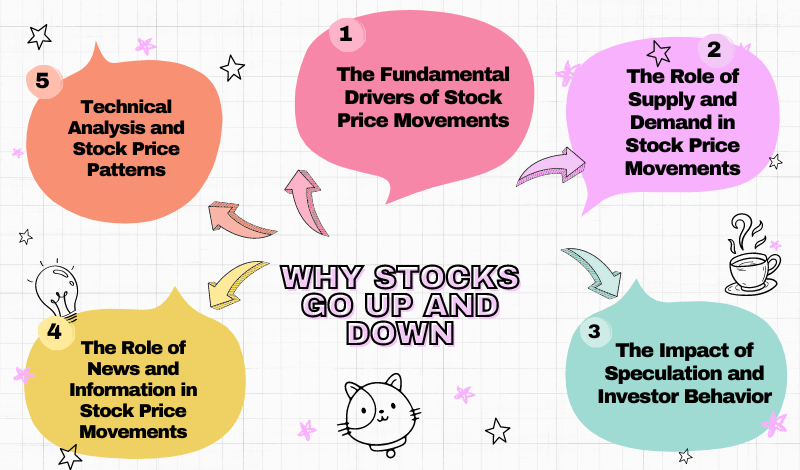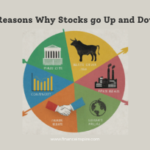Why Do Stocks Go Up and Down? Understanding Stock Market Dynamics
Introduction:
In the ever-changing world of stock markets, the fluctuation of stock prices is a constant phenomenon. One day, a stock may soar, while the next day, it plummets, leaving investors puzzled and intrigued. Understanding Why Stocks go Up and Down is crucial for making informed investment decisions and navigating the complexities of the financial markets. In this comprehensive guide, we’ll dive into the various factors that influence stock price movements and provide insights to help you better comprehend this dynamic landscape.
1. The Fundamental Drivers of Stock Price Movements:
At the core of Why Stocks go Up and Down lie fundamental economic and market forces that shape the supply and demand for a company’s shares. These drivers can be broadly categorized into two main categories: macroeconomic factors and company-specific factors.
Macroeconomic Factors:
Macroeconomic factors are overarching economic conditions that affect entire markets or sectors and contribute to Why Stocks go Up and Down. These factors include:
1. Economic Growth: Robust economic growth typically boosts corporate profits, leading to higher stock prices, while economic downturns or recessions can negatively impact stock valuations.
2. Interest Rates: Changes in interest rates can significantly influence stock prices. Lower interest rates generally make stocks more attractive compared to fixed-income investments, potentially driving stock prices higher. Conversely, higher interest rates can make bonds and other fixed-income securities more appealing, potentially causing a shift in investor preferences away from stocks.
3. Inflation: Persistently high inflation can erode the real value of future corporate profits, potentially leading to lower stock prices. However, moderate inflation can indicate a growing economy, which may be positive for stocks.
4. Currency Fluctuations: For multinational companies, fluctuations in currency exchange rates can impact revenues, expenses, and overall profitability, consequently affecting stock prices.
5. Geopolitical Events: Political instability, trade tensions, and global conflicts can introduce uncertainty into the markets, often leading to increased volatility and stock price fluctuations.
Company-Specific Factors:
While macroeconomic factors influence the broader market, company-specific factors play a crucial role in determining the performance of individual stocks and contribute to Why Stocks go Up and Down. These factors include:
1. Earnings and Profitability: A company’s financial performance, particularly its earnings and profitability, is a key driver of stock prices. Strong earnings and profitability tend to boost stock prices, while disappointing financial results can lead to a decline in stock valuations.
2. Revenue Growth: Investors often favor companies with strong revenue growth prospects, as it can indicate a healthy and expanding business. Robust revenue growth can contribute to higher stock prices, while stagnant or declining revenues may negatively impact stock valuations.
3. Management Effectiveness: The quality of a company’s management team and their ability to execute strategic plans effectively can significantly impact investor confidence and, consequently, stock prices.
4. Competition and Market Share: A company’s competitive position within its industry and its ability to maintain or increase market share can influence stock prices. Companies that successfully fend off competition and gain market share may see their stock prices rise, while those losing market share may experience stock price declines.
5. Product Innovations and Developments: Companies that introduce innovative products or services that disrupt the market or create new revenue streams can see their stock prices soar, as investors anticipate future growth potential.
2. The Role of Supply and Demand in Stock Price Movements:
While fundamental factors provide the underlying rationale for stock price movements, the interplay of supply and demand is ultimately what determines the actual prices in the market and contributes to Why Stocks go Up and Down. The basic principle of supply and demand applies to stocks just as it does to any other traded commodity.
Investor Sentiment and Demand:
Investor sentiment, which reflects the overall mood and expectations of market participants, plays a significant role in shaping demand for stocks and contributes to Why Stocks go Up and Down. Positive investor sentiment can increase demand for stocks, driving prices higher, while negative sentiment can reduce demand and contribute to falling stock prices.
Supply of Shares:
The supply of shares available for trading can also impact stock prices and contribute to Why Stocks go Up and Down. When a company issues new shares through stock offerings or employee stock options, it increases the overall supply of shares, which can potentially put downward pressure on stock prices. Conversely, when companies repurchase their own shares (stock buybacks), it reduces the supply of shares available for trading, potentially supporting higher stock prices.
Market Liquidity:
Market liquidity, which refers to the ease with which stocks can be bought and sold without significantly affecting their prices, is another important factor influencing stock price movements and contributing to Why Stocks go Up and Down. In highly liquid markets, large buy or sell orders can be executed without causing substantial price swings. However, in illiquid markets, even relatively small trades can significantly impact stock prices due to the limited availability of buyers or sellers.
3. The Impact of Speculation and Investor Behavior:
In addition to fundamental factors and supply-demand dynamics, speculation and investor behavior can also play a role in Why Stocks go Up and Down.
Speculation and Market Sentiment:
Speculation is the act of buying or selling assets based on the expectation of future price movements, rather than on fundamental analysis. Speculative activities can drive stock prices up or down, particularly in the short term, as investors attempt to capitalize on perceived market trends or rumors, contributing to Why Stocks go Up and Down.
Investor Psychology and Biases:
Investor psychology and behavioral biases can also influence stock price movements and contribute to Why Stocks go Up and Down. For example, the fear of missing out (FOMO) or herd mentality can lead investors to pile into certain stocks, driving prices higher, while panic selling can exacerbate market downturns. Overconfidence, anchoring, and other cognitive biases can also impact investment decisions and contribute to stock price volatility.
Market Overreactions and Corrections:
Markets can sometimes overreact to news or events, leading to exaggerated price movements in either direction. These overreactions are often followed by corrections, where stock prices readjust to more accurately reflect their underlying fundamentals. The process of market corrections can result in significant stock price fluctuations and contribute to Why Stocks go Up and Down.
4. The Role of News and Information in Stock Price Movements:
In the age of instant information and 24/7 news cycles, news and information play a crucial role in shaping stock price movements and contribute to Why Stocks go Up and Down.
Company News and Announcements:
Company-specific news and announcements, such as earnings reports, product launches, management changes, or mergers and acquisitions, can significantly impact stock prices and contribute to Why Stocks go Up and Down. Positive news tends to drive stock prices higher, while negative news can lead to price declines.
Economic and Market News:
Economic and market news, such as changes in interest rates, inflation rates, employment data, or geopolitical events, can also influence stock prices and contribute to Why Stocks go Up and Down. Investors closely monitor these developments and adjust their investment strategies accordingly, leading to stock price movements.
Analyst Upgrades and Downgrades:
Financial analysts play a crucial role in the stock market by analyzing companies and issuing buy, sell, or hold recommendations. Analyst upgrades or positive outlooks can boost stock prices, while downgrades or negative outlooks can contribute to stock price declines and Why Stocks go Up and Down.
Rumors and Market Speculation:
Rumors and market speculation, whether substantiated or not, can also impact stock prices. Unfounded rumors or speculation about a company’s prospects, potential mergers or acquisitions, or other significant events can sometimes trigger volatility in stock prices, at least in the short term.
5. Technical Analysis and Stock Price Patterns:
While fundamental analysis focuses on the underlying factors that influence stock prices, technical analysis involves the study of historical price patterns and trading volumes to identify potential buy or sell signals.
Chart Patterns and Indicators:
Technical analysts use various chart patterns, such as head and shoulders, triangles, and flags, as well as technical indicators like moving averages and oscillators, to identify potential support and resistance levels, trend reversals, and trading opportunities.
Momentum and Trend Following:
Momentum and trend-following strategies are used by some traders to capitalize on existing stock price movements. These strategies are based on the premise that stocks exhibiting strong upward or downward momentum are likely to continue in the same direction, at least in the short term.
The Debate: Fundamental vs. Technical Analysis:
The debate between fundamental and technical analysis has been ongoing in the investment community. Fundamental analysts argue that stock prices ultimately reflect a company’s underlying financial performance and prospects, while technical analysts believe that historical price patterns and trading behavior can provide valuable insights into future price movements.
Conclusion: Why Stocks go Up and Down
Understanding why stocks go up and down is a complex endeavor that involves a multitude of factors, ranging from fundamental economic and company-specific drivers to market dynamics, investor behavior, and technical analysis. While each factor plays a role in shaping stock price movements, it is essential to recognize that the stock market is a dynamic and ever-evolving ecosystem.
Investors who aim to navigate this intricate landscape successfully must adopt a holistic approach, incorporating both fundamental and technical analysis techniques. By carefully evaluating macroeconomic conditions, company performance, market sentiment, and historical price patterns, investors can gain valuable insights and make more informed investment decisions.
However, it is crucial to remember that stock price movements are inherently unpredictable, and even the most well-informed investors cannot accurately forecast every market fluctuation. Diversification, risk management, and a long-term investment horizon are essential strategies for mitigating the impact of stock price volatility.
Ultimately, understanding why stocks go up and down is an ongoing learning process that requires continuous research, analysis, and adaptability. By staying informed, embracing a disciplined approach, and remaining vigilant to market dynamics, investors can increase their chances of achieving their financial goals in the ever-changing world of stock markets.











